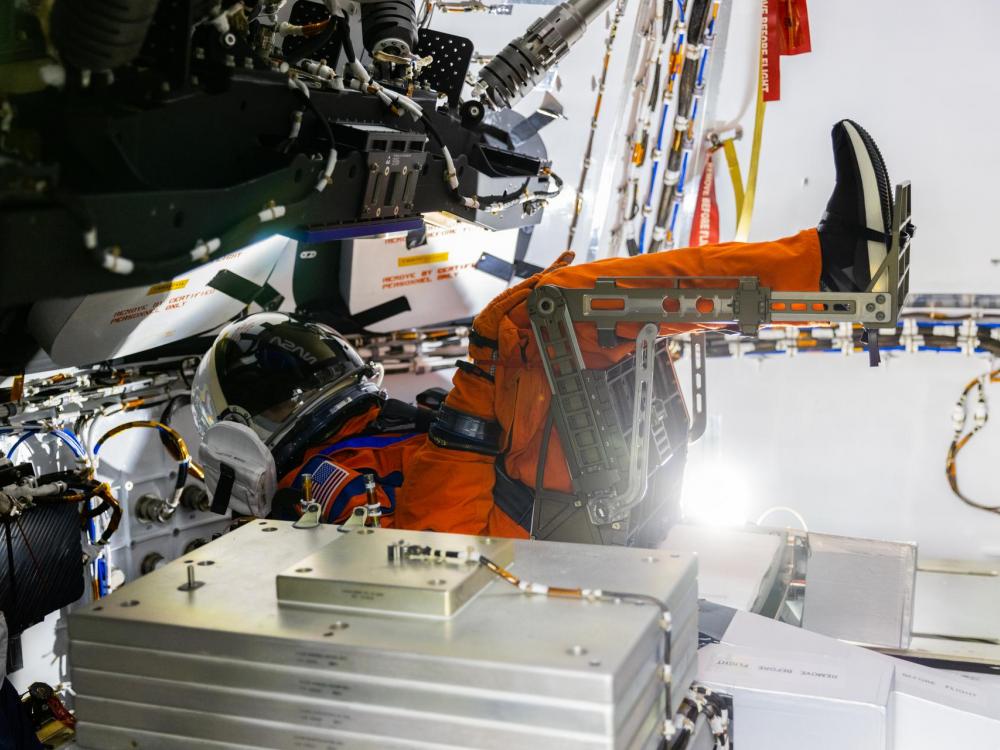
5 Things On Board NASA's Artemis I Mission
Nov 14, 2022
By Amy Stamm

Nov 14, 2022
By Amy Stamm
The Artemis I mission, scheduled to launch from Kennedy Space Center on Wednesday, November 16, at 1:04 am ET, is an uncrewed test flight of NASA’s new Moon rocket – the Space Launch System, aka SLS – and the Orion crew capsule that will take Artemis astronauts to the Moon and back starting with Artemis II.
Although this mission won’t have any astronauts riding along, there are other items on board to commemorate the occasion and conduct research to further the Artemis program and other projects being worked on at NASA and other research institutions around the world. Read on for five things hitching a ride on the Artemis I mission.
A view of Moonikin “Campos” secured in a seat inside the Artemis I Orion crew module atop the Space Launch System rocket in High Bay 3 of the Vehicle Assembly Building at NASA’s Kennedy Space Center in Florida on Aug. 3, 2022.
The next Artemis mission will have astronauts on board, so an important part of Artemis I is learning about what the trip into space will be like for future crews. On board the Orion spacecraft is a full mannequin (nicknamed Moonikin by public vote) featuring two radiation sensors and wearing a first-generation Orion Crew Survival System spacesuit. The seat the mannequin will be in also has sensors (under the headrest and behind the seat) to record acceleration and vibration during the mission.
Also on board are two “phantom torsos," mannequins with just a torso and head – no arms or legs – seated in two of the other seats on Orion as part of the Matroshka AstroRad Radiation Experiment (MARE). These phantom torsos are named Helga and Zohar and will be use to measure the amount of space radiation astronauts may experience inside the spacecraft during missions to the Moon. They will be wearing a radiation-shielding vest called AstroRad and the experiment will evaluate the vest’s impact in reducing exposure to radiation.
We are excited to have a number of small artifacts from the National Air and Space Museum collection flying on the Artemis I mission in the Official Flight Kit (OFK), a small package of commemorative items. By necessity, the items flown in the OFK have to be small and lightweight and the selection of items proposed by the Museum and approved by NASA reflects these criteria:
These items allow us to connect the history of the Apollo program with the future of lunar exploration.
NASA is using this opportunity to conduct additional science using small shoebox-sized satellites called CubeSats. According to NASA, "in addition to their efficiency, low cost and compatibility with larger payloads, CubeSats also offer opportunities for increased science return and operational support of larger missions.” The 10 CubeSats on board Artemis I, developed by spaceflight centers and universities around the world, will be conducting science focused on the Moon, the Sun, Earth, and more. Among them are:
Learn more about the CubeSats on board from NASA.
NASA’s Office of STEM Engagement’s Next Gen STEM project and the USDA Forest Service are partnering to send a thousand tree seeds on the Artemis I mission. If this sounds familiar, you’re right: this project builds on the legacy of Apollo’s Moon Trees, trees planted around the country from seeds flown on the Apollo 14 mission.
The Artemis Moon Trees will feature five difference species of tree seeds: Loblolly Pine, American Sycamore, Sweetgum, Giant Sequoia, and Douglas Fir. Once back on Earth, the Forest Service will germinate the seeds and begin the process of growing the next generation of Moon Trees.
Learn more about Moon Trees in a recent episode of the AirSpace podcast.
Snoopy, the Artemis I zero g indicator, looks at his ride to space which is stacked atop the SLS rocket inside the Vehicle Assembly Building.
What’s a mission without a great Zero G Indicator? Artemis I’s Zero G Indicator, an item used to indicate when a spacecraft has reached the weightlessness of microgravity, is a small Snoopy toy. Snoopy is a figure that has long been associated with NASA’s human spaceflight programs – Snoopy lends his name to NASA’s Silver Snoopy award (an award given by astronauts to individuals in recognition of exceptional work with relation to mission success and human flight safety) and when Apollo 10’s lunar module was named Snoopy, he became a mascot of that mission. A Snoopy toy first flew to space in 1990 on Space Shuttle Columbia’s STS-32 mission.

We rely on the generous support of donors, sponsors, members, and other benefactors to share the history and impact of aviation and spaceflight, educate the public, and inspire future generations. With your help, we can continue to preserve and safeguard the world’s most comprehensive collection of artifacts representing the great achievements of flight and space exploration.
We rely on the generous support of donors, sponsors, members, and other benefactors to share the history and impact of aviation and spaceflight, educate the public, and inspire future generations. With your help, we can continue to preserve and safeguard the world’s most comprehensive collection of artifacts representing the great achievements of flight and space exploration.